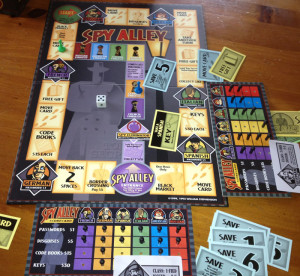
I credit my dear friend Sarah with getting me into board games; she would bring over something new to play every time she visited. Over the 15 years that we’ve been friends, she’s helped me discover some classics, such as Castle Panic, Forbidden Island, Puerto Rico, and this gem – Spy Alley. So when I saw it in the store, I had to pick it up for the nostalgia…and for the spies. There’s nothing I love more than deceiving people (in a game! I’m not a shady person, don’t worry), so this one is right up my alley. My spy alley, as it were.
Overview:
Spy Alley
Players: 2 to 6
Ages: 8 and up
Publish Date: 1992
BoardGameGeek link: click here
Gameplay/Rules:
In Spy Alley, players choose a spy identification card that is kept hidden from everyone else. They are also given money which will be used to buy the items they need. On your turn, you roll the dice, and move to the appropriate space. The object of the game is to collect all of your spy items (password, disguise, code book, and key) for the country you represent without giving away who you are. Items can be purchased by landing on their space on the board; once your item is purchased, you mark it off on your scoreboard so everyone can keep track of what you own. When you collect all of your items, you must enter spy alley and land on your embassy – the first player to do this wins the game. Other players can guess who you are before this occurs, but if they’re wrong, they lose the game. If they guess correctly, you lose. There is a space on the board that allows you to take a free guess, but the person you are calling out must be in spy alley – so that can be a bit tricky. You can also win by default if everyone else has been eliminated.

There are two sets of cards in Spy Alley: Move cards and Free Gift cards. You receive these by landing on their spaces on the game board. Move cards can be saved to play at a later time, or they can be used immediately; they let you move the number of spaces indicated on the card. This is helpful when you’re trying to land on your embassy or another important space. The Free Gift cards give you an item for free, and must be used immediately, with the exception of the Wild card. This adds an interesting element to the game, because you can collect the items you need without having to buy them and draw too much attention to your secret identity.
There are also other spaces on the board, such as Black Market (choose any one item to buy), Confiscate Materials (take an item from another player), and Border Crossing, where you must pay the bank $5.
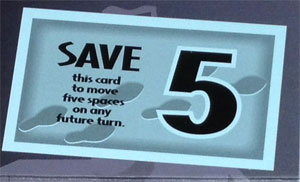
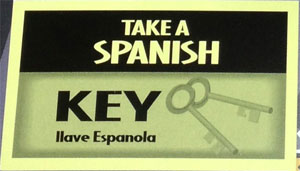
Overall, this is a very easy game to learn and play; the non-gamer could pick this up without a problem. It’s sort of like Monopoly meets Clue: you have to try and guess who the other players are by process of elimination, there’s dice-throwing, card drawing, and a lot of luck with which spaces you land on. Some people have said that there’s too much luck involved, and I don’t agree – strategy is huge in this game as well. You have to be aware of, not only of what items you are buying, but what your opponents are buying. You don’t want to give yourself away, but you also don’t want to waste money and only buy items you don’t need. There’s a fine balance that you must find, and that’s the most difficult part of Spy Alley.
Design:
The art in this game is very vibrant and cartoonish, which I like, yet it still has that mysterious quality to it. I guess the huge image of the guy in the trench coat under the street lamp helps with that. I had to laugh, because the characters representing the spies are so stereotypical of their respective countries. I mean, LOOK AT THE FRENCH LADY. She has a beret and everything. The Russian guy is all militaristic, and the American is just this random woman who looks like she’s been vacationing in Atlantic City.
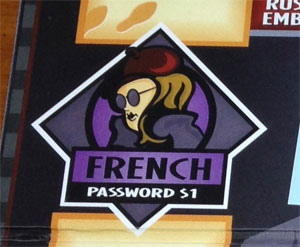
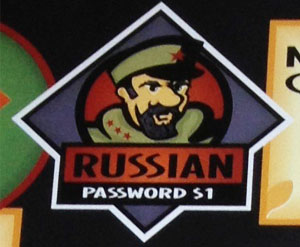
The game board and cards are made of quality, durable material. The peg and scorecard system works well enough, though sometimes it’s hard to see your opponents items because of the angle. The overall design and typography is simple, but effective.
Replay value:
Since your identity changes with every game, Spy Alley has a great replay value. I wouldn’t mind seeing an expansion though, with more countries and/or items involved.
The Gimp Glimpse: The text on the cards, rule book, and game board are large and easy to read/understand. Pushing the pegs into the scoreboards will be a problem for some (they were for me), as you have to push fairly hard to get them in. Then there’s the issue I mentioned before, about the angle and viewing your opponent’s scoreboard. I had to repeatedly ask my friend to lift up her card or tell me what she had. It may be a good idea to prop them up, but the game does not come with any components to do that – you just have to MacGyver it.
Additionally, during the game, you’ll accumulate a lot of Move cards and it can be difficult to hold and look through them all. If you generally have trouble handling cards or play money, just keep in mind that this game does have those elements.
Score:
I would give this game four stars out of five. A deceptively strategic game, with simple rules and a high replay value.

What is the wild card for?
It’s been such a long time since I’ve played this, and I no longer own the game. But check out the game via the BoardGameGeek link, and someone there can answer the question 🙂
The wild card can substitute any other card in a game.